Combat aircraft. Tirpitz, we were just stronger!
Most hated by the Germans
Probably, if someone during the Second World War organized a poll in Germany on the topic "Which plane is the most hated for the Germans", our today's hero would definitely get one of the prizes.
If the Americans flew mainly during the day, then the British pilots bombed both day and night. Statistics show that the Lancaster flew over 1942 sorties between 1945 and 155 and dropped over 000 tons of bombs on the Germans.
The Lancasters were the heavyweights of the RAF Bomber Command. They were the ones who carried all the brainchild of engineer Wallace: the 10-ton Grand Slam deep penetration seismic bombs and their predecessors, the 5,5-ton Tellboy bombs (hello, Tirpitz!), As well as the bouncing bombs to destroy dams ...
Lancaster was used successfully, but more than intensively: of the 7 built bombers, 300 (that is, in fact, half) were lost on combat missions. And the list of Lancaster victories is quite long.
In general, this aircraft can be safely called the most effective bomber of the Royal Air Force. And this despite the fact that, when the war had been going on for three months, the Avro engineers just sat down at the drawing boards for development.
Two owls from two ugly ducklings
In general, Lancaster is a child of some kind of misalliance. Alteration of a very mediocre bomber. But it so happened that two ugly ducklings turned out to be two ... (not a swan, of course) rather an owl.
However, let's go in order.
First there was the case. The case was two twin-engine medium bombers: "Avro-679" and "Handley-Page" HP.56. Perhaps these planes would become new pages in stories British Air Force, but alas. The Rolls-Royce "Vulture" engine nullified all the efforts of the designers. For the engine (to put it mildly) failed. Power in 1 780 hp from. was reduced to zero by the unreliability of the engine. And in the end, in 1940, Rolls Royce refused to continue work on it.
The only aircraft that somehow tried to fly with it was Avro "Manchester", produced in the amount of 209 units.
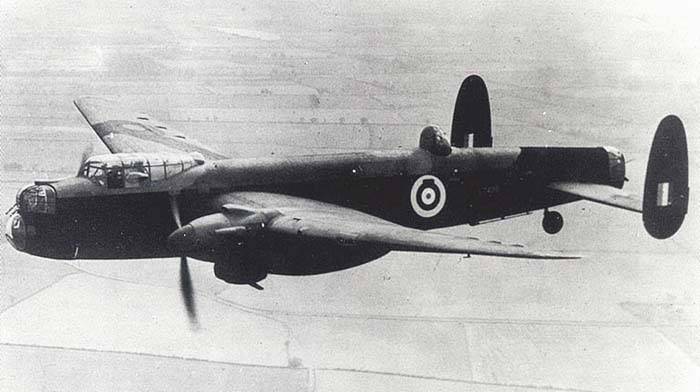
The order "Redo!"
Therefore, the continuation of the story was the word "Remake!"
The company "Handley-Page" immediately decided to take the bull by the horns. And instead of two "Walcher" they decided to put four "Merlin". This is how the Halifax heavy bomber appeared, which we will talk about a little later.
But there were no fools in the Avro either. So they immediately jumped on the idea of replacing the engine. This did not happen immediately. First, the engineers, under the command of Avro chief designer Chadwick, tried to replace Walcher with Napier Saber or Bristol Centauri. But then, in 1939, they came to the same conclusion as the engineers at the Handley Page: four Merlins were just that.
Replacing the power plant turned out to be a simple matter. Fuselage "Manchester" remained unchanged. Both the tail section and the central wing section were left unchanged. Naturally, by remaking the nacelles under the "Merlin". But for the third and fourth engines, new outer parts of the wing were designed. Enlarged and reinforced to carry two more engine nacelles.
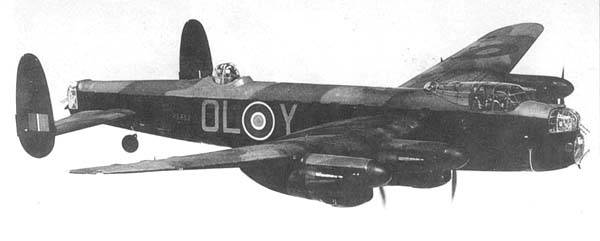
The Avro design bureau calculated that the four-engine bomber would be able to carry a bomb load of 5 kg at a distance of 448 km or 1 kg at 610 km at a speed of 3 km / h. At a more economical cruising speed of 632 km / h, the range increased to 2 and 574 km, respectively.
Lancaster I / P1
For 1939 - more than decent numbers. The project turned out to be promising compared to Manchester. Although it required more rework than it seemed at first. There was an idea that the four-engine "Manchester" is still a different plane and requires a different name. In addition, the first batch of "Manchester" at the very least, but was collected by the forces of "Avro" and "Vickers".
So in order to streamline all these alterations, in 1940 a new technical task "Lancaster" I / P1 was formulated. It contained numbers: a cruising speed of 402 km / h at an altitude of 4 m with a load of 575 kg of bombs at a distance of 3 km. The maximum range should be 405 km.
The bomb bay (roomy at the "Manchester") was preserved. And the plane had to carry a variety of loads: from one 1-kg and six 816-kg bombs to six 227-kg mines or six 681-kg, three 908-kg and up to 114 smaller bombs.
The Lancaster prototype was ordered in June 1940. And the plane made its first flight on January 9, 1941. This speed is due precisely to the unification of the two machines. In principle, they were structurally very similar. The Lancaster had a larger wing. Plus, the tail span was slightly increased, up to 10 m.

The defensive armament was completely borrowed from "Manchester": the FN5 turret with two machine guns in the nose, the FN20 with four machine guns in the tail, the lower FN64 with two machine guns and the upper FN50 with two machine guns. The machine guns were from Browning, 7,69 mm.
Tests have shown that Lancaster has excellent performance. Ministry aviation issued an order to stop production of Manchester. In order to accelerate the release of Lancaster, which took its place in all plans.
And the release of "Manchester" was stopped, not even fulfilling the first contracts.
The first production Lancaster flew on October 31, 1941, less than two years after work began. By the end of the year, a dozen more aircraft were ready for flight.
The Avro firm received an official order for Lancaster on June 6, 1941. It included 454 aircraft and replaced the January 450 order for 1940 Manchesters.
And as the aircraft were being assembled, orders began to come in further.
Innovations
Manufacturing Lancaster was not very difficult. And it allowed attracting a large number of factories. Structurally, the aircraft was divided into 36 large units, which could be ordered by subcontractors.
Since the war was going on, they decided not to innovate especially. The only innovation that has been applied in the design is the light-alloy cast units in the chassis retraction mechanisms. The landing gear struts were retracted into the nacelles back with a turn and closed with flaps. They decided not to remove the tail wheel in flight, they considered that the losses in drag were compensated by the lower weight and the absence of hydraulic lines to drive the retractable system.
Combat use was combined with tests. This happened on March 3, 1941, when 4 Lancaster ships laid mines off the Frisian Islands. On March 10, 2 aircraft took part in a bombing raid on German territory. True, exact data on where they flew and with what results have not been preserved.
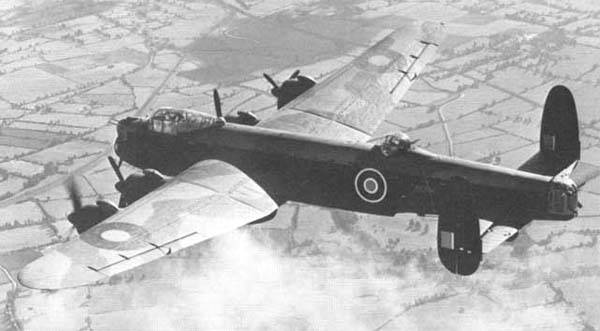
In total, more than 50 aircraft sorties were made as part of the tests. The losses amounted to one plane crashed during a forced landing due to the destruction of the wingtips.
Modification of the wing
All Lancasters delivered at that time went to the wing revision. And at the same time they began to dismantle from them (fortunately, it was technically provided for) the lower turrets, which were practically not used, but created resistance.
Another revision was made: the restrictive ring for the upper turret, which prevented the raging shooters from turning their aircraft into a sieve. There were precedents. The size of the tanks was also increased, now the fuel supply was 9 792 liters.
The shape of the bomb bay hatches was slightly changed, which made it even larger. And now it was possible to safely hang bombs weighing 3 632 kg and even 5 448 kg into it.
We finally decided on the booking. Part of this noble task was entrusted to the structure itself, increasing the thickness of the partitions and power parts to 8 mm. And, for example, turrets were armored during their production. Armor plates were widely used to protect the crew members in their places.
The crew consisted of the first pilot-commander, the second pilot, the navigator-observer-bombardier, two gunners-radio operators and two simple gunners. A total of seven people.
An interesting point. "Lancaster" was built in a very decent amount for a heavy bomber (for comparison - the USSR mastered 79 Pe-8). But there were only four serial options. This indicates that everything was originally planned as it should. It is at the development stage. So, the subsequent finishing touches and alterations were simply not needed.
Engines
Of course, the engine was the key. "Merlin" generally became a lifesaver for the aviation of the two countries. The first was "Merlin" of the 20-th series, giving 1280 hp. from. on takeoff with a boost of 0,84 kg / cm 1 and having a maximum power of 480 1 hp. from. at an altitude of 830 m. With these engines, the Lancaster had a maximum speed of 462 km / h at an altitude of 3 m with a take-off weight of 505 tons.
The working ceiling was 7 m and a range of 500 2 km with a bomb load of 670 6 kg. The speed with such parameters decreased to 356 km / h, which (in principle) was not critical during night raids.
Further development - "Merlin" 22nd series. Engine boost was increased to 0,98 kg / sq. cm, which made it possible to increase the engine power to 1 liters. from. It became possible to increase the takeoff weight of the aircraft by about a ton. The maximum speed increased to 560 km / h, while the range was 434 km from 3 kg.
And the last replacement of the engine - "Merlin" 24 series. These motors were installed on the later editions of the "Lancaster", 1945. "Merlin" series 24 had a boost of 1,27 kg / cm 1, takeoff power of 620 liters. sec., takeoff weight 30 872 kg or in overload, for shorter distances, 32 688 kg.
Built throughout Britain
Lancaster was built throughout Britain.
The production company "Lancaster Group" was formed, which was engaged in the production of aircraft.
The bombers were made directly at Avro (in Manchester, Woodford and Yedon), Metropolitan Vickers (Manchester), Vickers-Armstrong (Chester and Castle Bromwich), Armstrong-Whitworth (Coventry and Rigby), Austin Motors ”(Birmingham).
Merlins are not enough for everyone
At one time, British aircraft manufacturers feared that there would not be enough Merlins for everyone. And there was a variant of replacing "Merlin" with "Hercules" from the company "Bristol". The same "Armstrong-Whitworth" in the city of Baginton built these aircraft in a batch of 300 pieces. "Hercules" VI produced 1 liters. with., but the flight characteristics remained the same. Therefore, when the situation with the release of "Merlins" stabilized, the "Hercules" were abandoned.
And thus, from March 1942 until the end of the war, Lancaster became the main heavy bomber of the Royal Air Force. Halifax, which entered service earlier, was gradually losing ground.
And a year later, on March 6, more precisely on the night of the 5th to 6th, the main battle of Lancaster, the Battle of the Ruhr, began. Raids on the cities of the main industrial center of Germany - Essen, Duisburg, Dusseldorf, Dortmund and Bochum. Berlin, Munich, Stuttgart, Nuremberg and Hamburg also got attention.
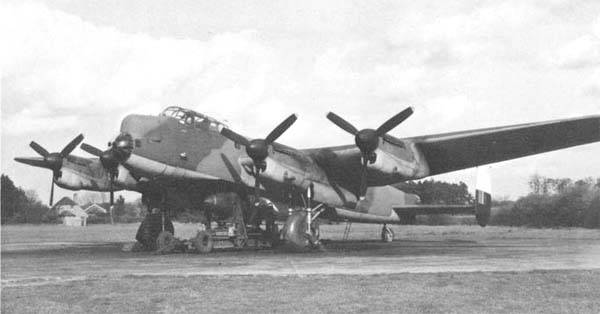
These were mainly night raids, since the British did not have fighters to accompany the proper range. But as the Luftwaffe lost ground, the British began raids during the day. But no one canceled the night raids, and the inhabitants of Germany were in for a very unpleasant time, when the howl of air defense sirens sounded both day and night.
The Lancaster took part in such operations as the "raids of 1 bombers" on Kiel, Cologne, Hamburg. But since the real benefit of these raids was not enough, the Lancasters were connected to them sporadically and in small numbers.
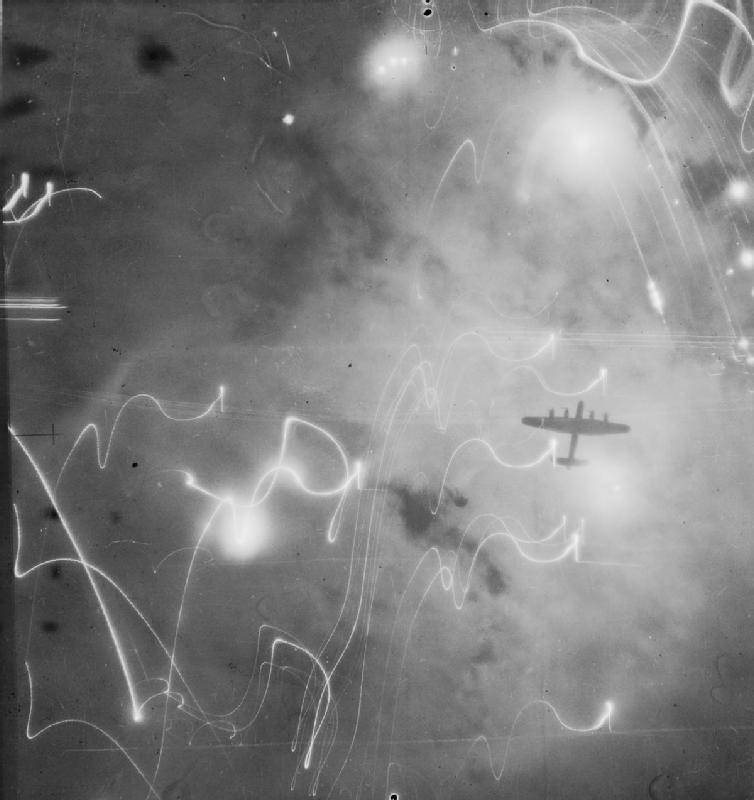
Like the propaganda attack of 12 aircraft on the MAN plant in Augsburg, when the Lancasters attacked during the day and in close formation. Not surprisingly, 7 out of 12 cars were shot down. But it was a very significant demonstration of the capabilities of the bomber command, albeit with very little success.
If the operations were planned without regard for the hype, then they usually ended in success. The Lancaster assets have successfully raided weapons Schneider plants in Creusot, France. Only one plane out of 93 was lost. And the factories suffered significant damage.
It was on "Lancaster" at the end of 1943 that the British first used radars for guidance and bombing. With the help of the Н2S radar "Lancaster", having overcome the Alps, they flew to Genoa and Turin. Where they worked on targets with heavy bombs 1 816 kg and 3 632 kg. The radar was placed under a translucent fairing at the bottom of the rear fuselage.
"Dumbasters"
But the most exciting operation in terms of technology and tactics was, of course, the Lancaster attacks on dams in West Germany. Operation Apkeep, carried out on the night of May 16-17, 1943, to destroy the Monet, Eder, Sorpe, Ennepe, Lister and Schwelme dams.
Special weapons were developed, engineer Wallace's jumping bombs, cylindrical bombs 127 cm in diameter, 152 cm long and weighing 4 kg, of which 196 kg were RDX explosives.
With these bombs, it was planned to destroy the dams that gave energy to the Ruhr enterprises.
The idea was interesting. A cylindrical bomb was unwound before being dropped, dropped, jumped on the surface of the water and, leaning against the dam, sank. And then the hydrostatic fuse was activated at a depth of 9 meters, and an explosion occurred.
The bomb was placed across the plane between two V-shaped frames. The circular discs at the ends of these frames were connected to the annular depressions at the ends of the bomb. One of the disks was driven by a belt drive from a hydraulic motor of the landing gear retraction system, spinning the bomb up to 500 rpm before dropping.
The bomb bay doors were removed because the bomb did not fit into the compartment. Special sights were installed, which made it possible to maintain the height specified for the drop (about 18 meters) and the distance to the target from which the drop was carried out (350ꟷ400 m).
Thus, 23 "Lancaster" was redesigned, which later received the nickname "Dumbasters".
On the night of May 15, 19 planes took off. The targets were Monet, Sorpe, Eder and Ennepe dams. Five planes that dropped bombs on the Monet Dam were successful. The dam was destroyed. The Eder Dam was also destroyed. The two remaining dams survived. And of the 19 planes that took off, 8 did not return to the base.
Bombs "Tellboy"
The Lancasters turned out to be the most convenient carriers of the Tellboy bomb, designed by the same Wallace, weighing 5 kg. The same guys who bombed the dam were at the helm of these planes with an enlarged bomb bay.
The first and immediately successful use of the Tellboy was the attack on the Saumur railway tunnel, through which the Germans drove reinforcements to Normandy. On the night of June 8-9, 1944, the tunnel was successfully blocked.
Kill "Tirpitz"
These same guys from 617 Squadron with the Tellboys chased the battleship Tirpitz for a long time. In general, the British tried to kill Tirpitz throughout the war. Back in April 1942 (having just started combat activities), Lancaster squadrons of 44 and 97 squadrons tried to "get" the battleship 1 kg with bombs. But it didn't work out.
In 1944, Lancaster squadrons 9 and 617 tried to attack the Tirpitz stationed in the Alten Fjord from Yagodnik airfield near Arkhangelsk. The attack was launched on September 15th. It seems that something got into the battleship. But it didn't do much damage. The Tirptz did not sink.
In October 1944, the Tirpitz went to Tromsø. There he could be attacked by flying out of Britain. "Lancaster" lost its upper turrets, received more powerful motors "Merlin" 24th series, the fuel supply was increased to almost 11 tons. You could fly.
The second raid also failed. In addition to spending 32 Tellboy.
And so (truly, God loves a trinity), on November 12, the Lancasters again dropped 28 Tellboys. And the two bombs finally hit the right place. The Tirpitz capsized and ended the war. And the 9th and 617th squadrons became specialists in the precision bombing of especially large ammunition. These two squadrons dropped 90% (854) of Tellboy bombs during the war.
"Grand Slam"
When the Lancasters equipped the even more destructive 9-kg Grand Slam bomb, it was natural that one of these squadrons would use it.
The first real drop of the Grand Slam from Lancaster took place on March 13, 1944 at a test site.
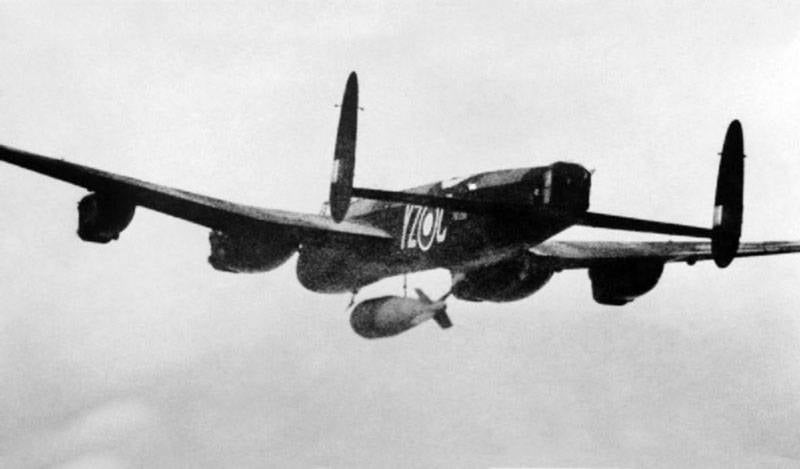
And the very next day, 14 Lancasters with Tellboy and one with the Grand Slam destroyed the Bielefeld viaduct in the city of the same name in North Rhine-Westphalia. This was the first of 41 Grand Slam, dropped by 617 Squadron before the end of the war. In general, the viaduct had no value, the bypass route was built a long time ago, as soon as the British began to bomb it. So - a political action, nothing more.
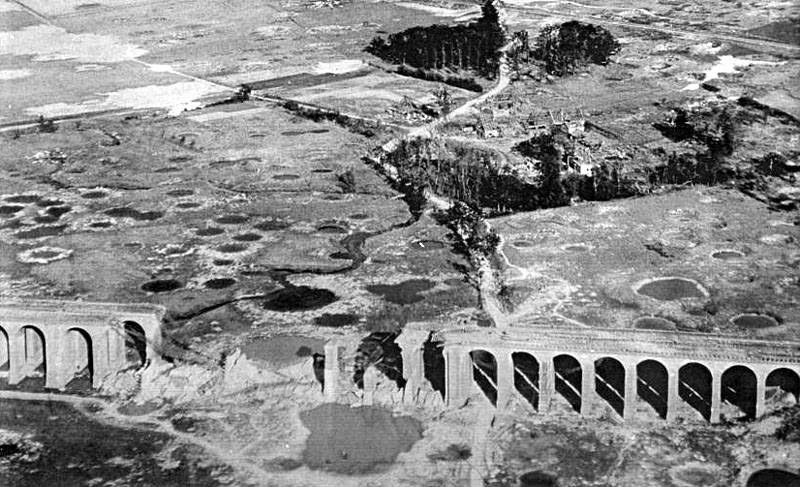
Speaking about the changes made to the design, it is worth noting that almost all "Lancaster" by the end of the war lost the lower gun mount, as unused. The rear fuselage mount coped quite well with the defense of the sector. Especially when instead of the FN20 they began to install the FN82 with two Browning 12,7 mm machine guns instead of four 7,69 mm machine guns.
The H2S radar bombsights were on virtually all aircraft.
Since the plane did not just "come in" as a bomber, but "flew in", it was used without being distracted by other specializations. There were cases when the Lancaster was transferred to the Coastal Command for a while, but the aircraft was not actively involved in operations at sea. But after the war, several squadrons on "Lancaster" were used as search and rescue aircraft and for long-range naval reconnaissance, fortunately, all flight characteristics allowed.
Last combat mission
The last combat sortie "Lancaster" made during the day on April 25, 1945. Moreover, it was a very massive flight. At first, about 200 planes bombed Berchtesgaden, where Hitler's refuge was. And at night 119 Lancaster bombed the oil storage depots of the submarine base in Oslofjord.
Further, the "Lancaster" had many sorties, but of a completely different nature. There were 3 flights with food for the cities of Holland, where problems began among the population. The Lancaster ships delivered over 156 tons of food to Dutch cities.
And the last task of the Second World War was the removal of British prisoners of war from German camps. 74 people were transported to Britain. Considering that more than 000 people were not included in the Lancaster's fuselage, it is very easy to calculate how the crews had to work hard. But all British soldiers and officers were taken home.
"Lancaster" naval aviation
And after the war "Lancaster" began to master quite peaceful specialties. Initially, it was decided to use the Lancaster as a search and rescue aircraft in the Pacific Ocean. A drop-down inflatable boat "Uffa-Fox" was specially developed for him. More precisely, the boat of the first model was intended for the Hudson and Warwick, and the second model was for the Lancaster.
Thus, 120 aircraft were converted into ASR modification.
About a hundred more "Lancaster" were converted into scouts GR.Mk.Z, which served in patrol squadrons in the Atlantic and Mediterranean.
The scout could also carry a rescue boat of the Mk.II or Mk.IIa types as an ASR. But the Lancaster GR.Mk.3 had an ASV III search radar in a fairing and did not carry an upper turret. One of these reconnaissance aircraft served at the Naval Intelligence School at St. Mougain until 15 October 1956, becoming the last Lancaster in the British Naval Air Force.
Another post-war variant was the Lancaster PR.Mk.I. It was a full-fledged reconnaissance aircraft, in which cameras were installed in the bomb bay. And it was used, respectively, for aerial photography. It was these aircraft that carried out photographs of the territories of Africa for subsequent mapping from 1946 to 1952.
As a bomber, Lancaster remained in service until March 1950. And then Lincoln was hired instead. But a fairly decent number of Lancasters were adapted for specific operations. These aircraft, the number of which is estimated at more than two hundred, served significantly longer.
The last Lancaster was reportedly fired from the Royal Air Force on April 1, 1964.
After the war, a significant number of aircraft were simply sold to other countries for conversion into transport, search and other modifications. "Lancaster" served in Argentina, Egypt, France, Algeria. For the French, in New Caledonia, one Lancaster served until 1964 as a search and rescue.
"Lancaster" in the Soviet Air Force
Two "Lancaster" managed to serve in the Soviet Air Force.
When Operation Paravan was carried out to capture and destroy Tirpitz, British aircraft were based for a long time at Yagodnik airfield near Arkhangelsk.
38 "Lancasters", 2 transport "Liberators" and one scout "Mosquito" flew to the USSR.
The disgusting weather was the reason that not all flew. 10 Lancasters boarded an emergency landing in Onega, Belomorsk, Kegostrov, Molotov (Severodvinsk) and just in the tundra. One car landed in such an inconvenient place that the parachutist-guide had to be thrown off. He took the crew to the river, where the MBR-2 flying boat was waiting. 7 aircraft were damaged. One of them was repaired by our and British specialists.
On September 15, 27 Lancaster ships, including the refurbished one, bombed the Tirpitz and flew back to Britain. The battleship remained afloat. The British had no losses.
But we still have 6 aircraft in varying degrees of damage. It so happened that two could be restored using the rest as donors. These "Lancaster" were delivered to Kegostrov, where in the workshops of the White Sea military flotilla they were restored to flight condition.
The chief engineer of the flotilla, Kiryanov, supervised the work. All weapons were removed from the bombers. The rear turret was sewn up with duralumin sheets. The color was left British, with only red stars with black borders instead of circles.
The first plane got into the 16th transport squadron, formed on the basis of the 2nd separate air group of I. Mazuruk. The detachment was called transport. But the planes also flew for ice reconnaissance, search for enemy submarines, and patrolling. "Lancaster" under the control of V. Evdokimov (navigator V. Andreev) also flew on combat missions to search for submarines and patrol, although it had no weapons.
But the aircraft brought the greatest benefit precisely in patrolling remote areas of the Northern Sea Route and ice reconnaissance in remote areas.
The second restored Lancaster ended up in the 70th separate transport regiment (brigade) of the Northern Fleet Air Force. The commander of this vehicle was I. Dubenets. After the 16th trao was disbanded in 1946, the first aircraft was added to it.
The first plane eventually ended up in Riga as an exhibit at a naval aviation school. And his further fate is unknown. The second plane was destroyed while landing at the Izmailovo airfield in Moscow. They did not restore it.
In general, evaluating the entire project, it should be said that the Lancaster is one of the most successful aircraft of the Second World War.
So no flaws that it is surprising.
LTH Lancaster Mk.III
Wingspan, m: 31,09
Length, m: 20,98
Height, m: 6,19
Wing area, sq.m: 120,80
Weight, kg
- empty aircraft: 16 753
- maximum take-off: 32 688
Engines: 4 x Rolls-Royce "Merlin 24" x 1 640 hp from.
Maximum speed km / h: 462
Cruising speed, km / h: 350
Practical range, km: 4 312
Practical ceiling, m: 7 468
Crew, prs: 7
Armament:
- 2 machine guns 7,69 mm in the nose turret
- 2 machine guns 7,69 mm in the dorsal turret
- 4 machine guns 7,69 mm in the tail installation.
Bomb load:
- up to 6 350 kg bombs or one 9 979 kg bomb.
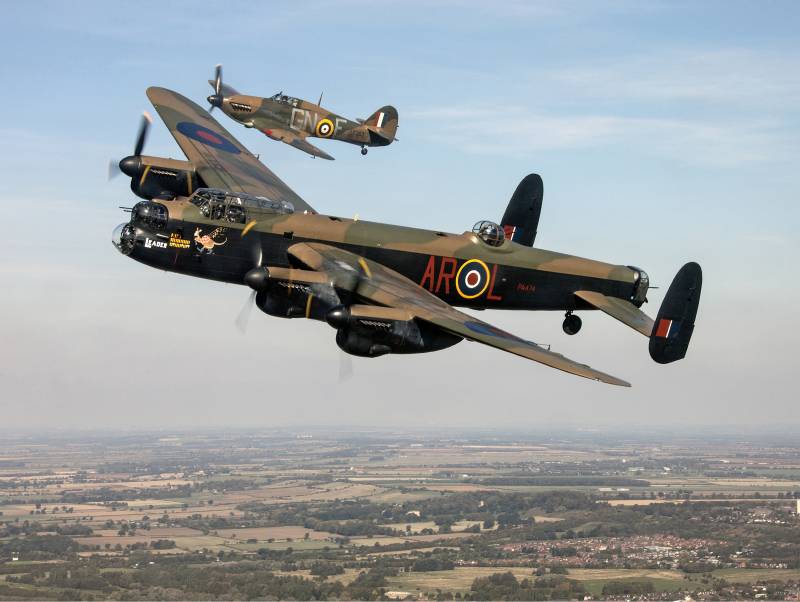
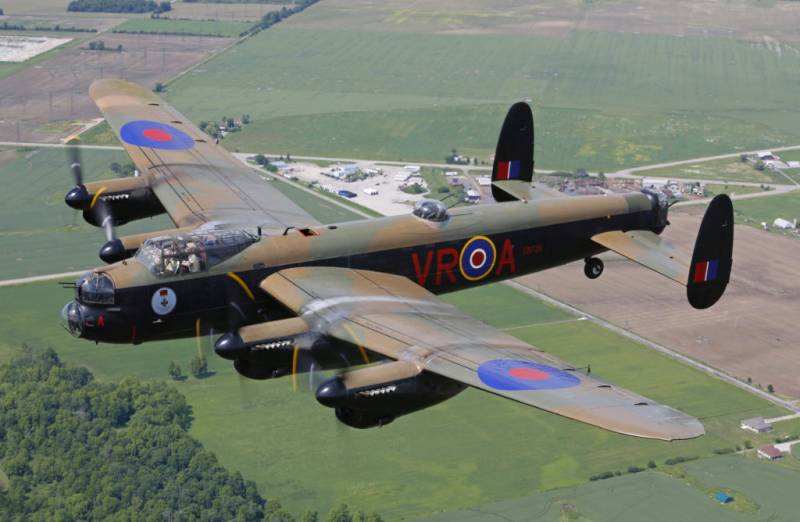
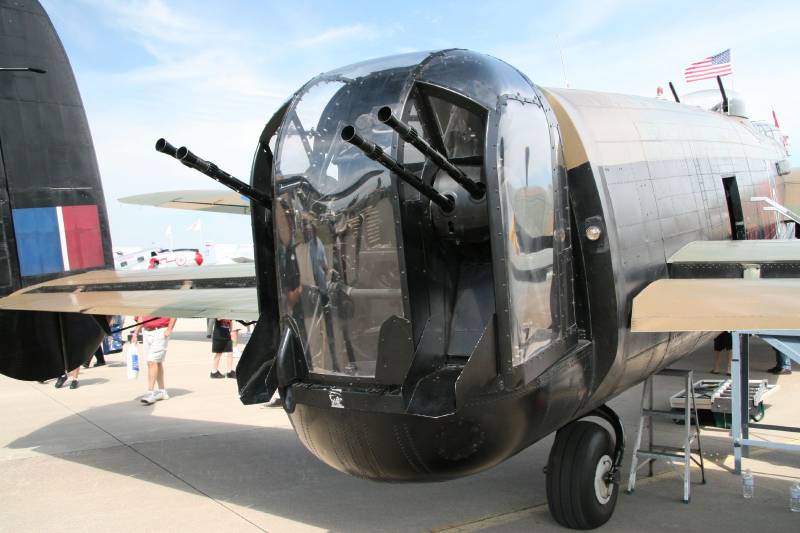
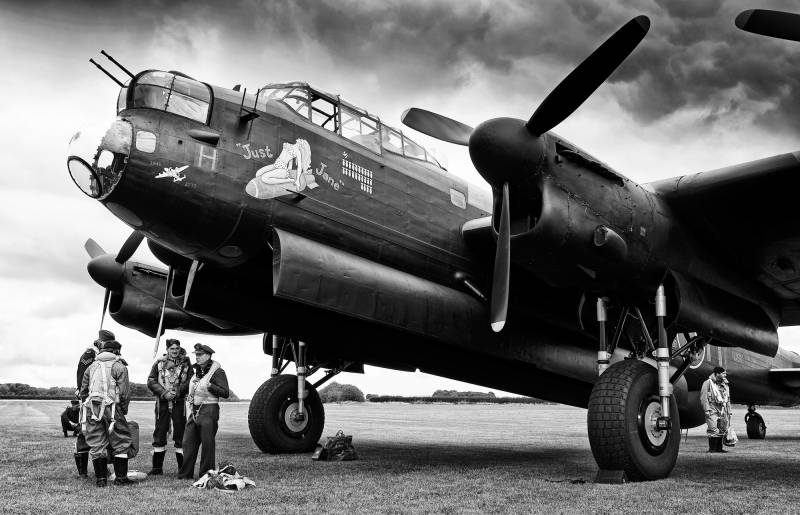
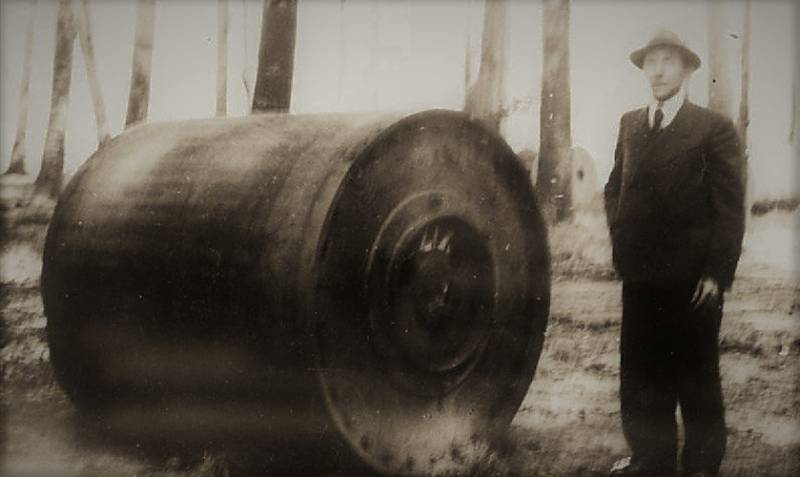
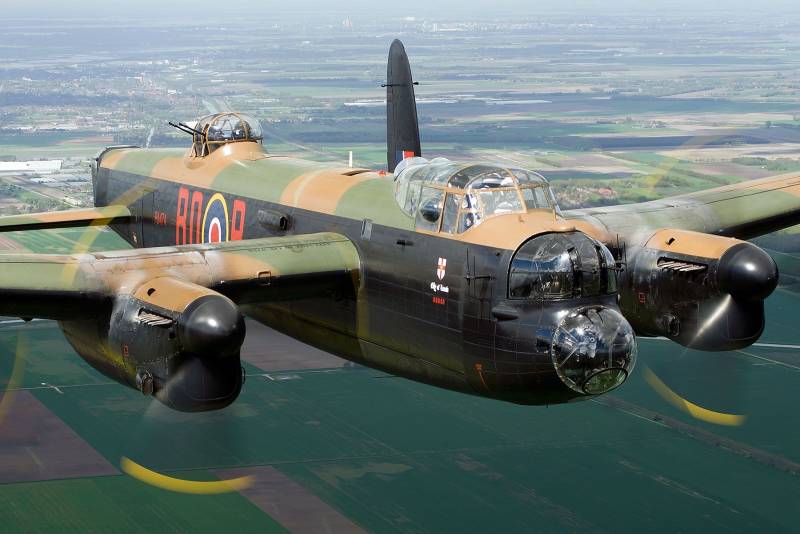
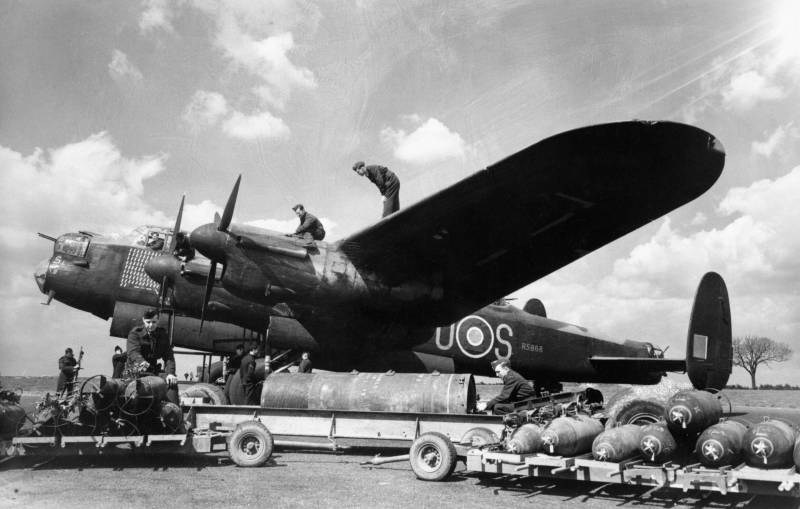
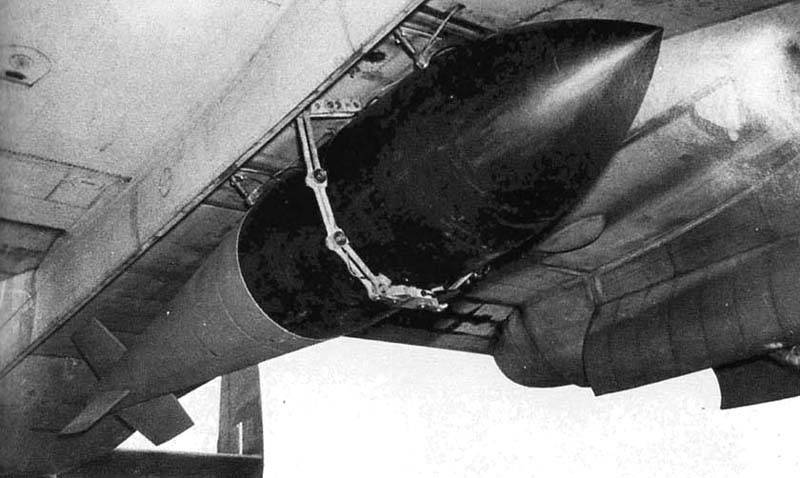
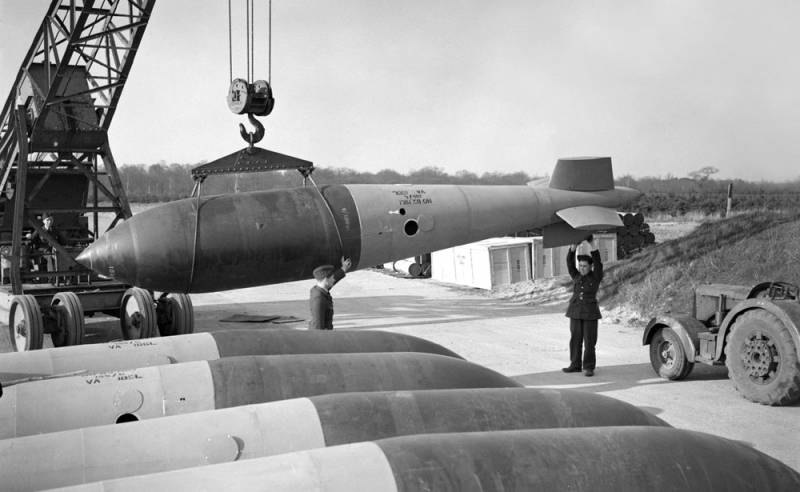
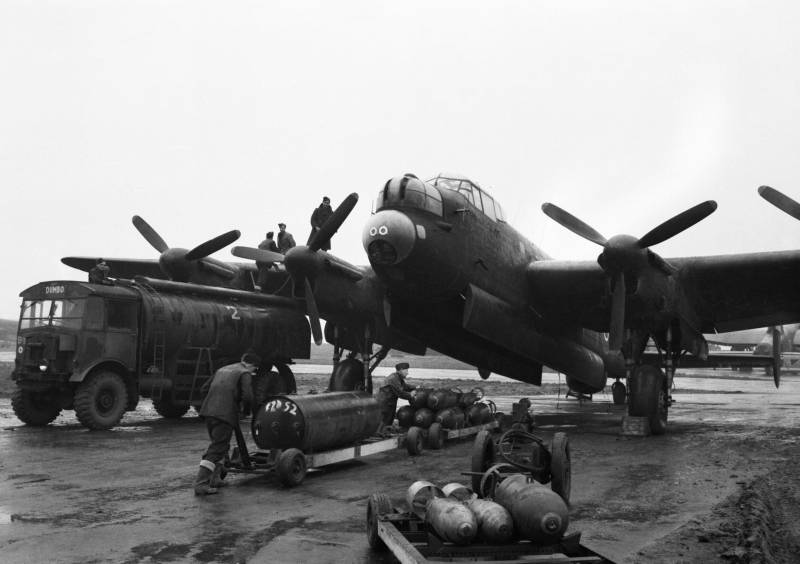
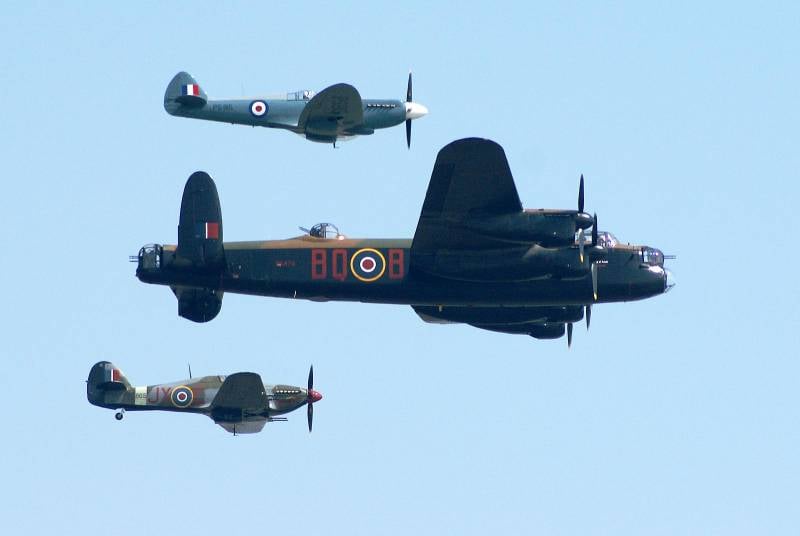
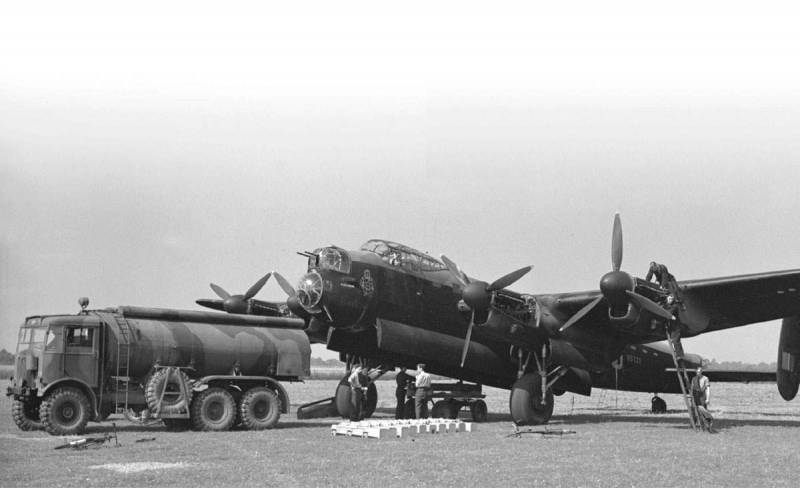
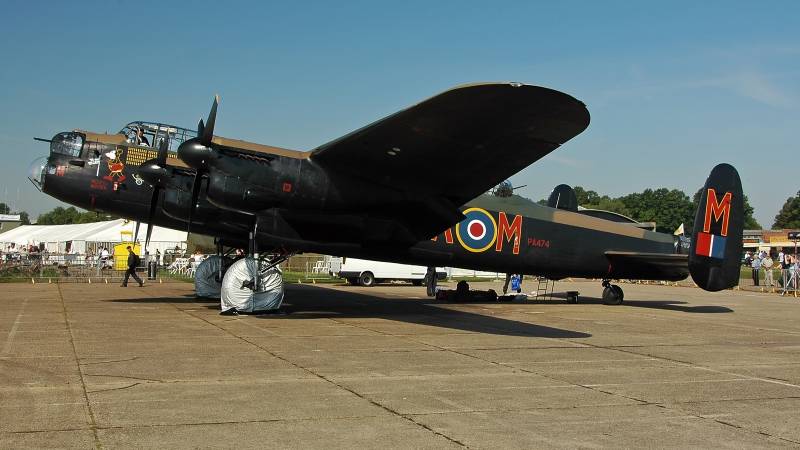
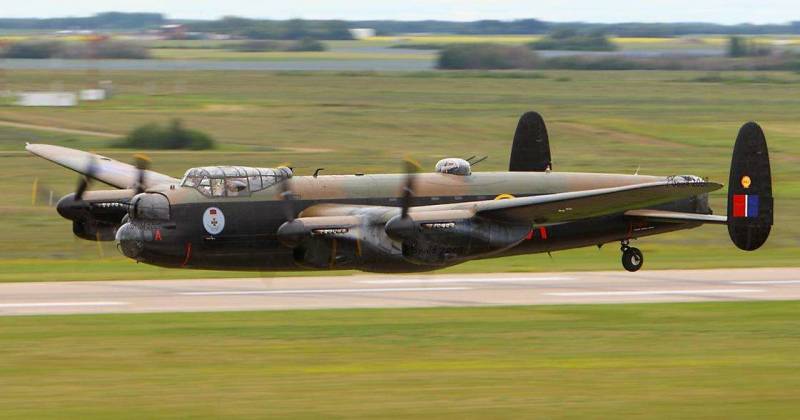
Information